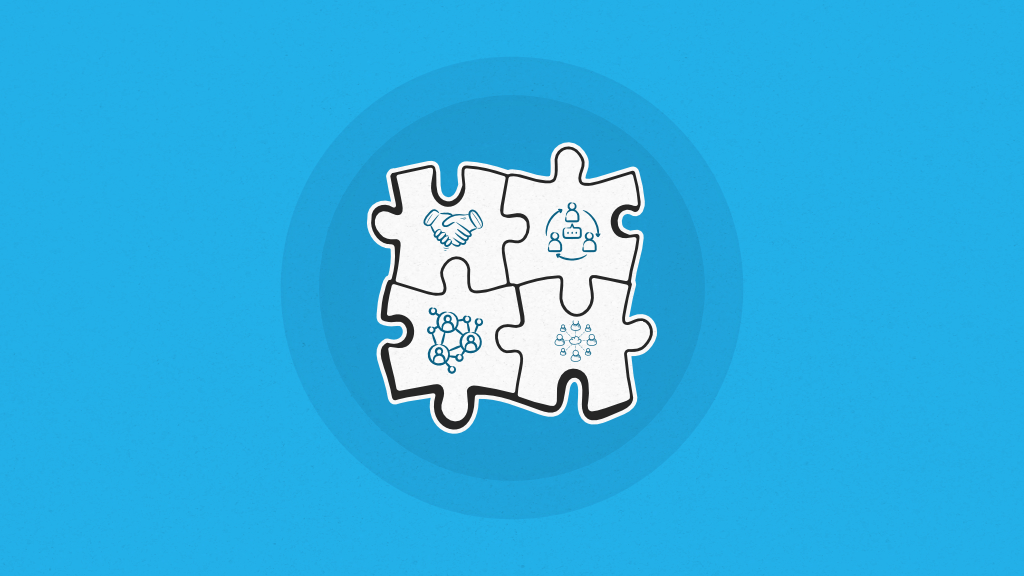
Collaboration types describe the different ways individuals, teams, and organizations work together to achieve shared goals. The main types of collaboration used in workplaces today include internal, external, cross-functional, real-time, virtual, and strategic collaboration.
By learning how collaboration types differ, you can match the right model to your goals, tools, and culture, ensuring stronger alignment and measurable results. Each type of collaboration has a distinct structure, participants, and outcomes, shaping how information is exchanged, decisions are made, and results are delivered.
The shape each type of collaboration takes depends on three things: purpose, participants, and process.
Collaboration can be short-term and task-driven, such as a product team working to deliver a new feature under a deadline, or long-term and strategic, like leadership teams exploring the company’s future direction.
The participants involved also make a difference. Collaboration within a single team or organization often benefits from shared context and aligned goals, while cross-functional collaboration brings diverse expertise but also brings clashing priorities.
Process is the third defining factor. Some collaborations follow formal structures with clearly defined workflows, decision-making rules, and standardized tools. In contrast, others thrive in more informal, flexible settings that rely on spontaneous interaction and shared understanding.
Each type comes with its own advantages and trade-offs. Knowing which approach to use can make all the difference in whether collaboration succeeds or struggles. The article covers 26 different collaboration types, knows how they work, and when they give you the most significant advantage.
1. Internal collaboration
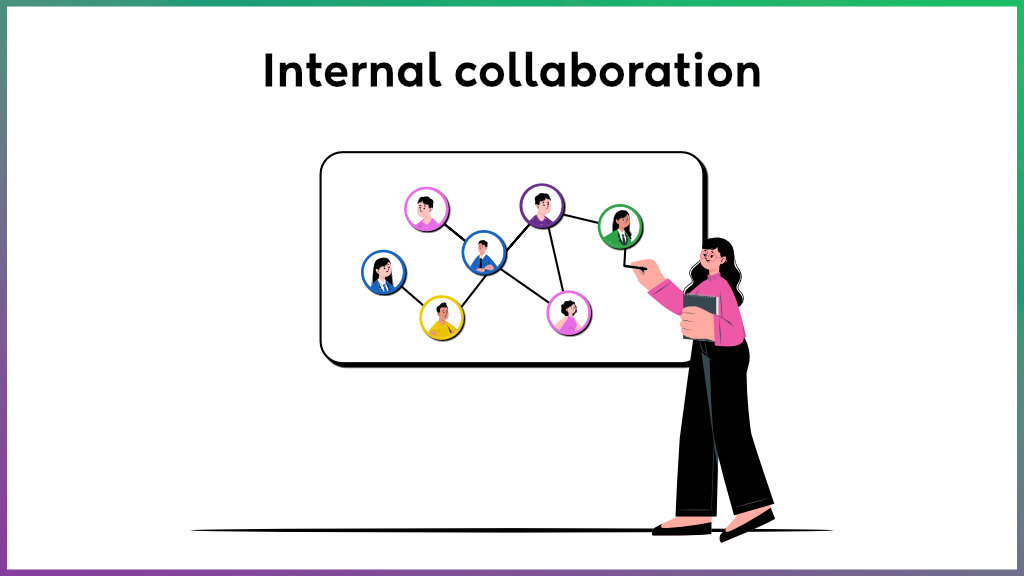
Internal collaboration refers to the processes through which individuals, teams, departments, and other units within an organization work together to achieve common goals. It is an internal organizational process designed to solve problems and exchange knowledge by enabling communication, coordinated decision-making, and the sharing of resources across all individuals working in the organization.
Internal collaboration happens through both formal and informal means.
- Formal practices generally include structured meetings, defined workflows, and digital collaboration tools. These mechanisms ensure clarity, accountability, and a consistent flow of information.
- Informal collaboration, by contrast, happens through spontaneous exchanges, quick problem-solving conversations, unstructured feedback, or ad hoc knowledge sharing. These informal relationships and interactions often make up for the gaps left by formal systems.
Together, formal and informal collaboration facilitate the flow of information within an organization.
Internal collaboration occurs between people belonging to the same as well as different departments. For example, two developers working on the same project, a marketing and sales team collaborating on a new campaign, or a dev and QA team collaborating on code, etc.
A comprehensive study conducted by East Tennessee State University to evaluate the importance of effective internal collaboration found that 93.8% of respondents agreed or strongly agreed that internal communications systems were vital. While the benefits are manifold, the practical applications of internal collaboration can be better understood by categorizing and analyzing them across four broad categories as follows:
| Interaction | Format | Purpose | Characteristics | Outcome |
|---|---|---|---|---|
| Decision Making | Complex and multifaceted | Meetings, structured discussions, review boards | Make uncertain, hard, and strategic decisions | Quality debates, established standards, protocols |
| Creative Problem Solving | Open-ended and generative | Brainstorming sessions, workshops, innovation labs | Identify innovative solutions, explore alternatives | Divergent thinking, idea-building, less hierarchy, psychological safety |
| Coordination | Task- and process-oriented | Project boards, stand-ups, workflow tools | Align work, clarify responsibilities, ensure execution | Clear roles, timelines, checkpoints, visibility across teams |
| Information Sharing | Routine and ongoing | Knowledge bases, reports, team chats, updates | Disseminate knowledge and keep everyone informed | Accessibility, transparency, documentation, emphasis on clarity |
To sum up, internal collaboration is the mechanism that allows organizations to stay adaptive, innovative, and resilient in an environment where challenges demand cross-functional solutions. Without it, even the smartest people and the best tools work in silos.
2. External collaboration
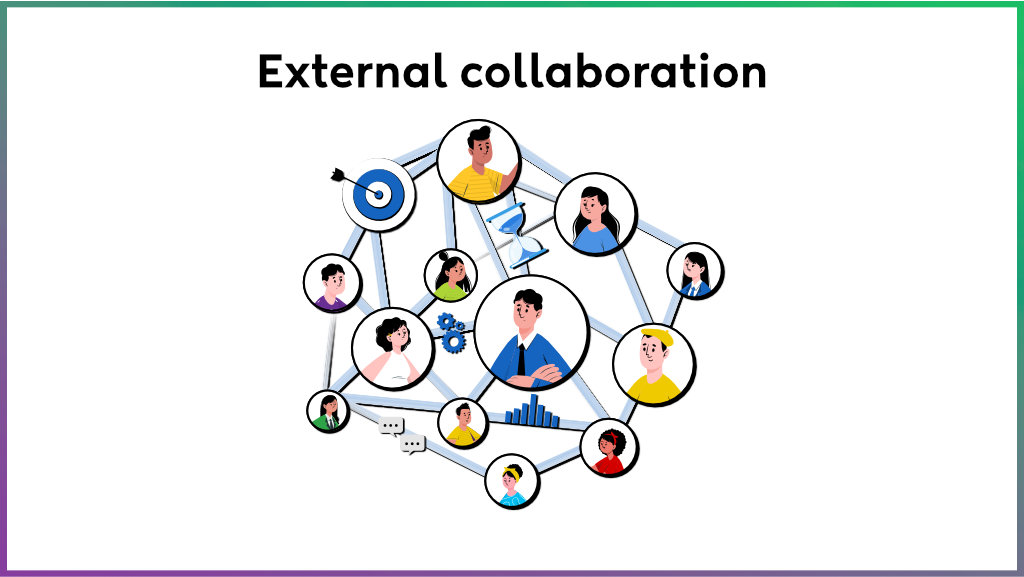
External collaboration is the process through which an organization engages with entities outside its organizational boundaries. These include suppliers, customers, competitors, research institutions, and other external stakeholders. The goal of any such form of collaboration is to achieve objectives by co-creating value and sharing talents, knowledge, or resources.
External collaborations are important because modern business challenges are too complex to be solved in isolation. Partnering with external experts can speed up innovation, improve efficiency, and open new opportunities.
A 2022 study published in Nature’s Humanities and Social Sciences Communications journal on the impact of external collaboration on firm growth capability suggests that vertical collaboration (with suppliers/customers), horizontal collaboration (with competitors), and competitor collaboration positively affect a firm’s research and development intensity, which in turn leads to improved growth.
When executed well, external collaboration gives organizations access to ideas and capabilities beyond their own. It creates a mindset shift that defines the most resilient businesses today.
In practice, external collaboration requires clear agreements, trust, and systems that make information sharing safe and efficient. Legal frameworks like NDAs and data-sharing protocols set boundaries, whereas collaboration platforms allow distributed teams to work together in real-time.
3. Strategic collaboration
Strategic Collaboration is a long-term partnership between two or more organizations that come together to achieve mutually beneficial outcomes. The participants in such collaborations are often companies, startups, research institutions, or even competitors who recognize that combining their unique strengths can create entirely new opportunities.
Unlike short-term or transactional partnerships, strategic collaborations focus on transforming capabilities, entering new markets, or developing innovative products and services that generate value in ways that would be impossible independently.
The purpose of strategic collaboration is to co-create emergent value rather than merely improve existing processes. Instead of focusing on immediate cost savings or efficiency gains, partners aim to build new capabilities, access new customer segments, or create new business models.
The success of such collaborations is often measured in terms of long-term strategic outcomes, like market position, competitive advantage, or the creation of new options for future growth. Because these results take time to develop, the collaboration typically spans multiple years, requiring patience, sustained trust & investment, and ongoing adaptation.
4. Business collaboration
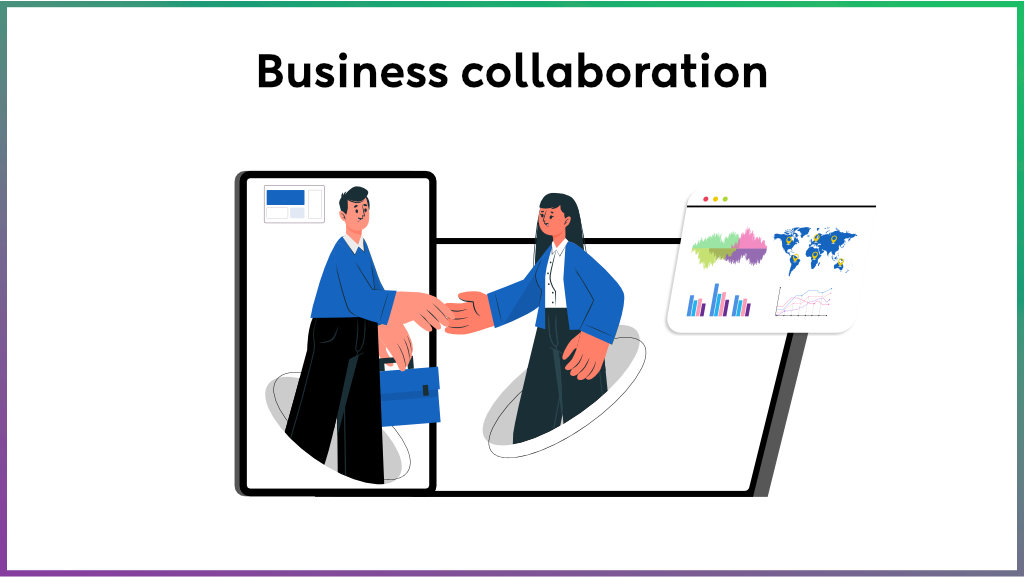
Business collaboration refers to partnerships between two or more independent organizations that work together primarily to improve efficiency, optimize existing operations, or achieve shared commercial objectives.
Participants can include companies, nonprofits, startups, or public institutions, and the collaboration usually focuses on leveraging each partner’s existing strengths and resources rather than creating entirely new capabilities. Unlike strategic collaborations, the emphasis is on coordination and mutual benefit within established frameworks, rather than on long-term transformative change.
The success of business collaboration is generally evaluated through operational metrics such as cost savings, revenue growth, process efficiency, timely delivery, etc. The goals are more immediate and tangible, and have a shorter time horizon than strategic collaborations, often yielding measurable results within a few months to a couple of years.
In business collaboration, structures and boundaries are defined by formal agreements, contracts, or service-level commitments to ensure accountability. It helps organizations operate more effectively by sharing resources and expertise, without fundamentally increasing the costs.
5. Knowledge collaboration
Knowledge collaboration is the deliberate coming together of people, teams, or organizations to create new understanding, insights, or solutions that no individual or single organization could generate alone. Unlike simple information sharing or moving data from one place to another, knowledge collaboration is about collective sense-making.
Participants usually include domain experts, generalists who span multiple fields, facilitators who guide the process, or even entire networks of organizations working toward a shared challenge. The purpose of knowledge collaboration is to solve complex problems, innovate, or build new frameworks of understanding that would be impossible for a single mind or organization.
It thrives on diversity of thought: when people with different cognitive frameworks and experiences come together, they can see patterns, connections, and possibilities that would otherwise remain hidden. Success is measured less by immediate efficiency or financial returns and more by the quality of insights generated, new knowledge frameworks created, and the potential for applying these insights in meaningful ways.
The process of knowledge collaboration is inherently different from operational or business-focused collaboration. Participants contribute across disciplines or teams. Risk is mostly intellectual, including concerns about idea ownership or reputation, but the potential reward is breakthrough understanding or innovative solutions.
6. Client collaboration
Client collaboration is the process of businesses and their clients actively working together to improve outcomes, co-create value, and deepen the impact of a service or solution. Rather than treating clients as passive recipients or mere buyers, this approach repositions them as long-term strategic partners. It shifts the traditional vendor-buyer relationship toward one of joint ownership, continuous dialogue, and mutual growth.
From a strategic standpoint, client collaboration is grounded in Stakeholder Theory (Freeman), which argues that businesses must consider and integrate the interests of all key stakeholders, including clients, into their decision-making processes. Clients contribute insights, constraints, context, and goals that shape outcomes. They become co-creators of value.
The process of client collaboration differs from traditional project delivery in several ways. Value is co-created rather than additive, timelines focus on mid- to long-term impact, and success metrics include solution effectiveness, capability transfer, and relationship sustainability.
Boundaries between client and provider roles are flexible, with mixed teams contributing expertise, iteratively prototyping ideas, and jointly reflecting on outcomes. Risks and rewards are shared, requiring both parties to embrace vulnerability and trust, while governance relies on adaptive frameworks rather than rigid contracts.
A famous example is Johnson & Johnson’s response to the Tylenol crisis. It was strengthened by the trust built through long-standing client collaboration. Their ability to recover market position was tied not only to operational moves but to relational capital accumulated over time.
7. Cross-functional collaboration
Cross-functional collaboration happens when people with different expertise, such as marketing, software development, project management, etc., come together to work on the same problem. Instead of staying within the bounds of their own departments, they form mixed teams—designers sit with engineers, marketers with product managers, analysts with operations—so the work reflects the combined knowledge of the organization.
The value here is not just efficiency but creativity. By breaking away from silos, teams are able to see problems from multiple angles, anticipate blind spots earlier, and build solutions that are stronger than what any one group could manage on its own.
Cross-functional collaboration reliably broadens the range of solutions teams can produce. In practice, it is a structured way of working that changes the horizon of what a team can achieve. It makes innovation more likely by ensuring the right mix of minds are present from the beginning.
8. Cross-department collaboration
Cross-department collaboration occurs when entire departments within an organization, such as sales, marketing, finance, HR, or operations, work together to achieve a shared objective. A department is a formal unit made up of people who perform similar work.
For example, the finance department manages budgets, while the HR department oversees hiring and employee policies. The purpose of cross-department collaboration is typically to coordinate and align activities across individual departments.
The outcome of effective cross-department collaboration is clarity, efficiency, and reduced friction between parts of the organization. It ensures that resources are allocated wisely and that departments support each other rather than compete.
9. Cross-team collaboration
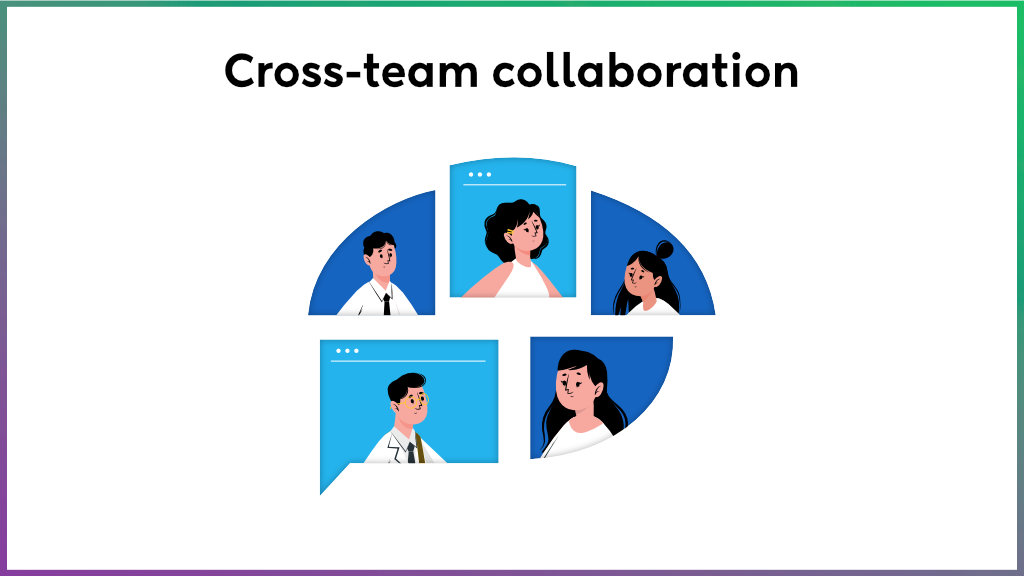
Cross-team collaboration refers to the interaction between distinct working teams, regardless of function or department, who coordinate to complete interdependent tasks, resolve shared problems, or deliver integrated outcomes.
Unlike cross-functional or cross-department collaboration, which are structurally defined, cross-team collaboration is more fluid and delivery-driven. It often occurs within matrix or project-based organizations where autonomy is high, yet outcomes depend on synchronization across multiple workstreams.
This type of collaboration is most visible in agile environments, sprint-based projects, product lifecycles, or customer-facing operations, where various teams, such as product, design, engineering, QA, or customer support, must collaborate closely despite operating on separate mandates.
Cross-team collaboration thrives on coordination mechanisms rather than hierarchy. Teams typically retain autonomy but are required to engage in shared rituals, tools, and communication practices to stay aligned. This interplay makes it a key site for understanding how modern, decentralized organizations operate under pressure.
10. Interdepartmental collaboration
Interdepartmental collaboration refers to the structured interaction between multiple departments within an organization to align goals, coordinate processes, and execute enterprise-level strategies through shared responsibility and information flow.
At scale, organizations are composed of differentiated departments—each with its own priorities, cultures, and workflows. Interdepartmental collaboration exists to bridge these boundaries. Unlike ad hoc or project-based teamwork, this form of collaboration emphasizes the integration of long-term processes and mutual interdependence.
Static coordination mechanisms—such as hierarchy or formal reporting—often fall short. Effective interdepartmental collaboration, therefore, requires adaptive structures that fit the organization’s strategy, size, and context.
The success of interdepartmental collaboration hinges on more than tools or reporting lines. It depends on intentional process design, shared incentives, and a culture of mutual accountability. Techniques like joint KPIs, cross-department OKRs, or co-ownership of deliverables formalize collaboration.
11. Project Collaboration
Project collaboration happens when people come together to work on a temporary initiative with a defined goal, timeline, and outcome. Unlike routine departmental work, projects have a clear start and finish—for example, launching a new product, organizing a company event, or upgrading internal systems.
The people involved are selected based on the skills the project needs. A marketing project might include writers, designers, and data analysts, while a construction project could bring together architects, engineers, and finance staff. Sometimes all participants come from within the organization (internal collaboration), and other times outside partners like vendors or consultants are included (external collaboration).
The process usually follows three stages: planning (setting goals, roles, timelines), execution (carrying out the work, solving problems), and closure (delivering results and capturing lessons learned). What makes project collaboration unique is its temporary, goal-driven nature. When the project ends, the team often disbands—though the relationships, trust, and shared methods can carry forward into future work.
12. Document Collaboration
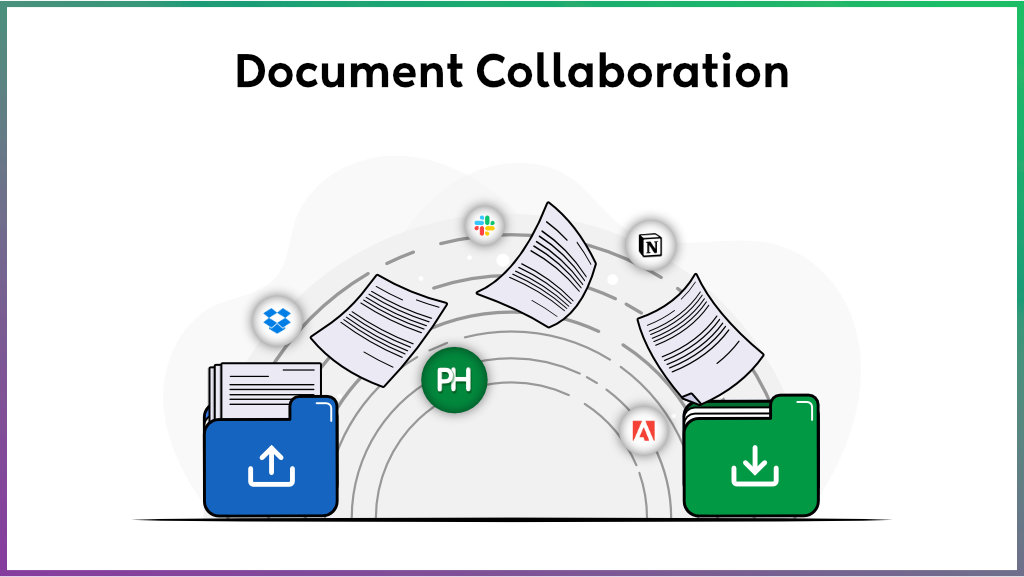
Document collaboration refers to the process by which multiple individuals work together (often simultaneously) on creating, editing, reviewing, and finalizing a shared document. It is enabled through digital tools that support real-time input, version control, commenting, and shared access.
Historically, document collaboration was linear and fragmented. Contributors worked in silos, passing files back and forth via email or shared drives. This model introduced friction through, version conflicts, unclear edits, and redundant feedback cycles.
The rise of cloud-based platforms fundamentally altered this dynamic. Tools like Google Docs and Microsoft 365 enabled asynchronous and synchronous collaboration, where contributors could co-edit in real time, leave contextual comments, suggest revisions, and access historical versions—all without leaving the platform.
13. Content collaboration
Content collaboration refers to the coordinated effort of multiple contributors, writers, editors, designers, marketers, and subject-matter experts, working together to create, refine, and distribute content across channels. It spans the full content lifecycle, from ideation and planning to creation, review, and publication.
The collaborative nature of content work mirrors project-based delivery. Much like in project collaboration, content production requires defining a scope (e.g., campaign goals, brand guidelines), assembling a cross-disciplinary team, establishing timelines, and using task coordination platforms.
Editorial calendars serve as the roadmap. Style guides function as shared governance protocols. Stand-ups and asynchronous reviews mirror agile ceremonies. The entire process becomes a structured yet iterative workflow—where deadlines coexist with creative exploration.
However, collaboration introduces creative tension. Writers may push for narrative originality while editors enforce brand tone. Designers advocate for visual clarity that may conflict with textual density. SMEs demand accuracy that slows down timelines. These frictions are not flaws—they’re features.
Effective content collaboration creates structured environments where such trade-offs are surfaced, debated, and resolved constructively. Clear editorial governance, shared goals, and negotiated norms help channel creative tension into better outcomes.
14. Marketing collaboration
Marketing collaboration involves the joint effort of internal teams, external partners, and cross-disciplinary stakeholders to design, execute, and optimize integrated campaigns that align with business goals and deliver cohesive brand experiences across channels.
Unlike isolated marketing functions, where content, design, SEO, performance, and brand operate independently, marketing collaboration creates a unified workflow that connects these domains. It ensures that campaign strategy, creative execution, and customer targeting evolve in sync.
Whether it’s launching a new product, entering a market, or running a seasonal campaign, collaboration determines whether marketing efforts scale strategically or fragment under competing priorities.
At its core, marketing collaboration is cross-functional by necessity. Strategy teams define objectives, content creators craft narratives, designers build visual identity, performance marketers manage distribution, and analysts measure outcomes. These roles must continuously align on messaging, goals, and timing—especially in omnichannel environments. The challenge is not just coordination, but orchestration.
15. Design collaboration
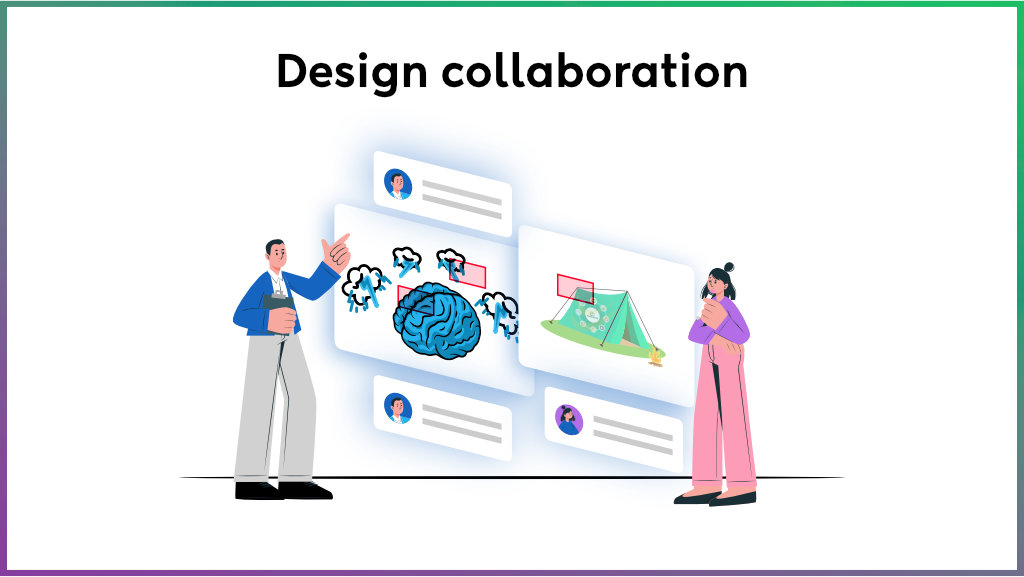
Design collaboration is a process of co-creating solutions through the active involvement of designers, developers, product managers, marketers, and other stakeholders across disciplines. It aligns creativity with constraints, ensuring that user-centered ideas translate into real-world, scalable experiences.
Generally, design collaboration is a continuous, multilayered conversation. Designers bring visual thinking and user empathy. Engineers introduce feasibility and performance logic. Product teams contribute business context, priorities, and user insights. These inputs rarely align perfectly. What makes collaboration effective is the ability to work through it—openly, repeatedly, and constructively.
Modern design work takes place inside complex environments. As organizations scale, so do the design functions: brand design, product design, UX research, motion, and accessibility. Each may use different tools, reference different style guides, and report to other stakeholders.
This is where design teams face a unique kind of interpretive complexity, not just operational. A single design component (like a homepage hero) may mean different things to different contributors: a performance load to engineering, a storytelling anchor to marketing, a branding symbol to leadership.
16. Creative collaboration
Creative collaboration is a process of generating, refining, and executing original ideas through the combined efforts of individuals with diverse talents, perspectives, and disciplines. It thrives on shared imagination, negotiated vision, and the ability to translate abstract concepts into tangible outcomes.
Unlike task-based teamwork, which focuses on efficiency, creative collaboration is inherently messy. It’s not about aligning inputs—it’s about shaping something new together. Writers, illustrators, videographers, designers, art directors, and strategists come to the table with their own interpretations of the problem. The challenge is to fuse these interpretations into a coherent, resonant idea—without flattening their uniqueness.
Creative collaboration works best when individuals feel safe to contribute without fear of judgment. This is where psychological safety becomes critical. Creative teams must be able to express risky ideas, challenge conventions, and experiment publicly.
Without trust, collaboration collapses into conformity. Brainstorming becomes silent compliance. Feedback becomes a threat. Great teams design safety into their process—by building critique into rhythm, setting clear roles for ideation and refinement, and separating the person from the work.
17. Remote collaboration
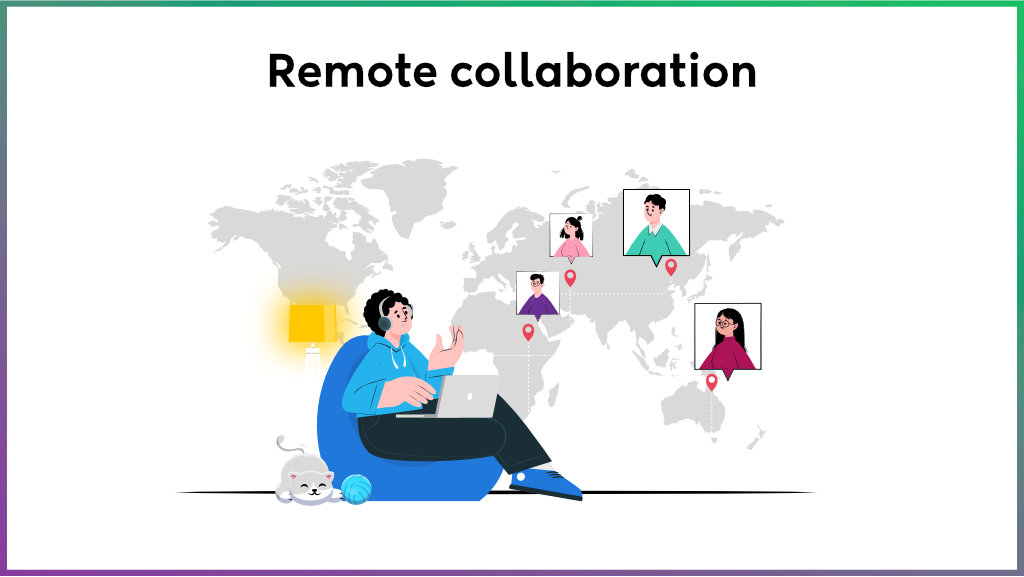
Remote collaboration is the process of individuals working for an organization from physically separate locations using digital tools. It enables organizations to connect with distributed employees, streamline workflow, and maintain productivity by removing geographical barriers.
While both virtual and remote teams utilize digital tools, remote teams are often distributed geographically. In a remote setup, effective collaboration occurs when participants take ownership of both their tasks and their visibility. Work is done in real-time as well as asynchronously, and priorities shift across time zones, so teams have to take ownership of their work.
For example, a remote team member responsible for a campaign asset might receive a task with a deadline, reference documents, and a feedback thread—all in a team collaboration platform. After submitting the draft, they tag relevant reviewers, see changes requested, and deliver revisions—without needing a live call. This allows teams to make decisions in real-time, maintain transparency about campaign progress, and solve problems quickly without needing to be in the same office.
This clarity supports efficiency and builds trust in a remote setting. When people do what they say, when they say it—and document it transparently—remote collaboration becomes sustainable.
18. Virtual collaboration
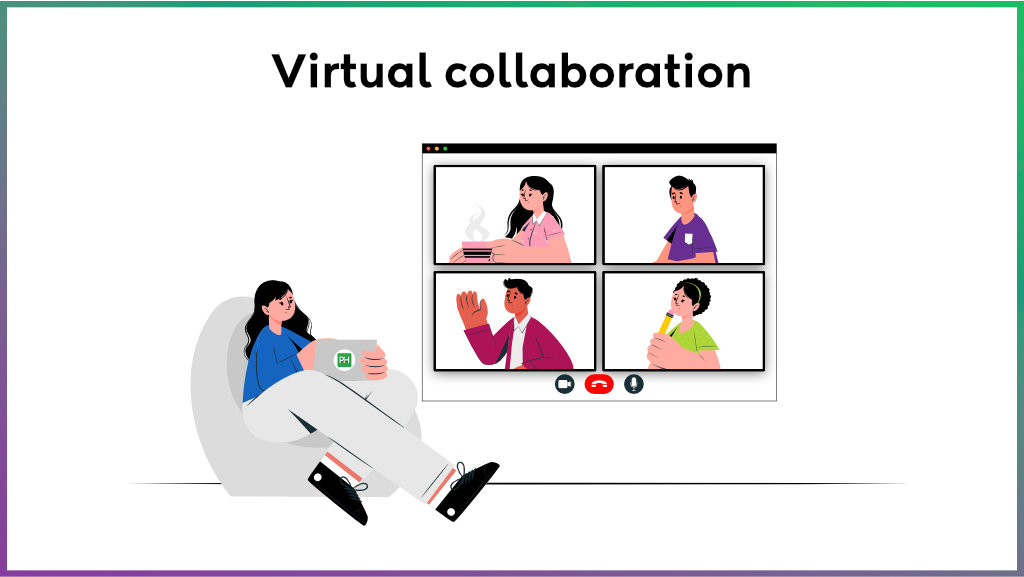
In virtual collaboration, people work together through digital tools, regardless of whether team members are physically co-located or distributed. Team members share information, communicate, and manage tasks using digital platforms.
It enables people across locations and time zones to align, communicate, and work on shared goals using online tools such as video conferencing, shared workspaces, instant messaging, and cloud platforms.
Digital tools are key to virtual collaboration. They allow teams to track task progress and deadlines, share documents, files, comment and share feedback, and centralize all the communication. The system becomes the team’s shared brain, reducing friction and improving responsiveness.
Still, tools alone can’t create connections. People collaborate more effectively when they feel cognitively and emotionally present with others—even through screens. This presence must be engineered through intentional behaviors: weekly check-ins, async stand-ups, visible feedback, and digital gestures of acknowledgement. These rituals substitute for the micro-interactions of office life—and when practiced consistently, they foster trust, rhythm, and shared momentum.
19. Hybrid collaboration
Hybrid collaboration refers to the process of coordinating work between individuals who are split across both in-office and remote environments. Unlike remote or virtual collaboration, where all participants operate under similar constraints, hybrid collaboration introduces asymmetry—some people share physical space while others do not.
The central tension in hybrid settings is access: access to conversations, to informal cues, to decisions made in the margins. This is why communication channel choices also matter. In hybrid setups, mixing modes wisely—pairing synchronous rituals with asynchronous structure—creates cognitive balance and prevents fragmentation.
One of the subtler risks of hybrid collaboration is influence inequality. Office-based team members may receive more visibility, more feedback, or greater sway in decisions—simply due to presence. To counter this, high-performing hybrid teams normalize documentation, rotate facilitation roles, and ensure that digital-first thinking shapes every process.
20. Synchronous collaboration
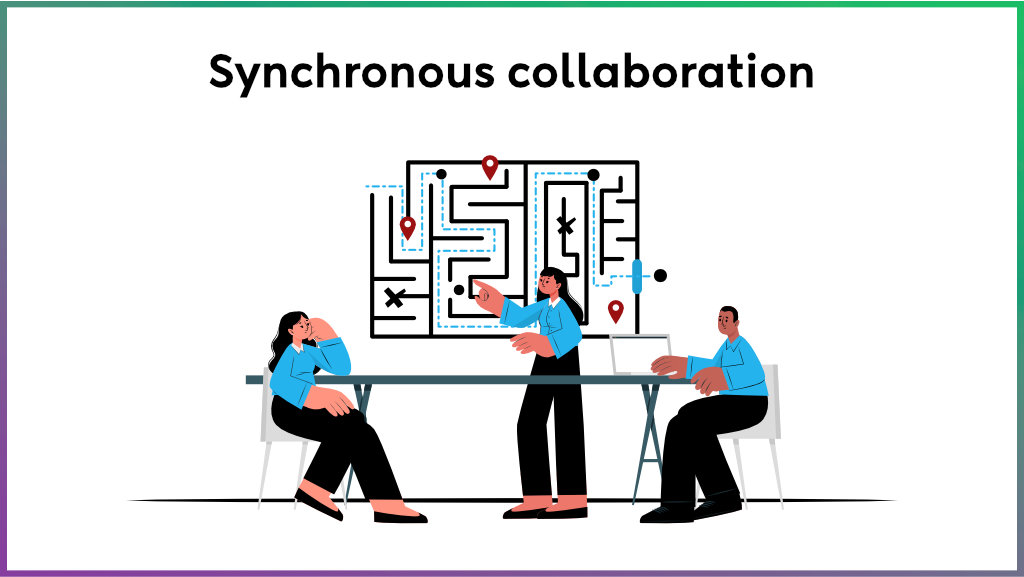
Synchronous collaboration is the act of working together in real time, where all participants are actively present—whether physically or digitally—and engaging simultaneously toward a shared task. It allows teams to coordinate rapidly, respond immediately, and align mental models in the moment. What defines this mode is not location, but shared time context.
Synchronous collaboration is most effective when the work requires immediacy, mutual feedback, or joint sense-making. It excels in brainstorming sessions, crisis response, fast decision cycles, or emotionally nuanced discussions where latency creates drag. It demands attention synchronization, which becomes costly across time zones, energy levels, or schedules.
Poorly structured synchronous sessions often suffer from redundancy, decision fatigue, or dominance by a few voices. When communication exceeds a group’s capacity to process it effectively, performance suffers. Synchronous interaction should be a tool for clarity, not noise.
Synchronous collaboration is not superior to asynchronous—it is situational. Its power lies in resolution: removing blockers, aligning priorities, or accelerating insight. The key is knowing when to activate it—and ensuring it lands inside systems that sustain the progress it enables.
21. Asynchronous Collaboration
Asynchronous collaboration is the process of contributing to shared goals without requiring participants to be present at the same time. Communication, updates, and decision-making happen across time zones, schedules, and attention spans—allowing people to think, respond, and act independently while still working toward collective outcomes.
The core advantage of asynchronous collaboration lies in temporal flexibility. Unlike synchronous modes that demand immediacy, async collaboration decouples work from time pressure. This enables deliberate thinking, uninterrupted focus, and participation from globally distributed contributors. In complex problem-solving, it gives room for analysis rather than reaction.
22. Cloud collaboration
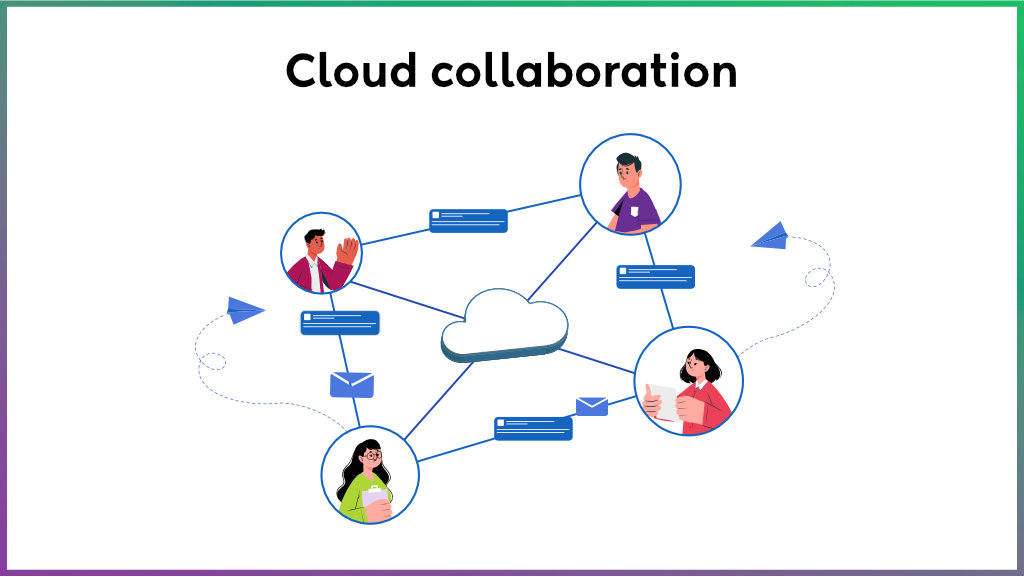
Cloud collaboration is the practice of using internet-based platforms to co-create, manage, and share work across devices, locations, and time zones. It enables teams to operate in a centralized, continuously accessible workspace—regardless of whether contributors are remote, hybrid, or on-site. This form of collaboration is less about who is involved, and more about how the work gets done.
What distinguishes cloud collaboration from traditional digital workflows is that the workspace itself lives online—not on individual machines or private servers. Every document, discussion, task, or timeline exists in a shared, persistent environment.
Teams can access the same assets, update them in real time or asynchronously, and maintain version continuity without the chaos of email threads or disconnected tools.
23. Community collaboration
Community collaboration is a model of joint effort in which individuals or loosely affiliated groups work together outside formal organizational structures to achieve shared goals, often motivated by a collective mission rather than economic incentive or managerial oversight. It is commonly seen in open-source projects, civic initiatives, knowledge-sharing communities, and social movements.
Unlike structured business collaborations, community collaboration depends on voluntary participation, decentralized governance, and shared norms of contribution. It emphasizes inclusion over control, modularity over hierarchy, and self-organization over centralized planning. This makes it a powerful, but complex form of collaboration, capable of both immense innovation and organizational ambiguity.
Successful community collaboration requires infrastructure that supports modular participation, transparency, and asynchronous communication. This is where collaboration platforms can play an important role.
For instance, in a community-driven education project involving researchers, designers, and volunteers, a collaboration tool can serve as the central space for task coordination, shared documentation, discussion threads, and iterative feedback—without enforcing rigid hierarchies. It offers the structure needed to coordinate volunteers while preserving the flexibility required for open collaboration.
24. Cross-cultural collaboration
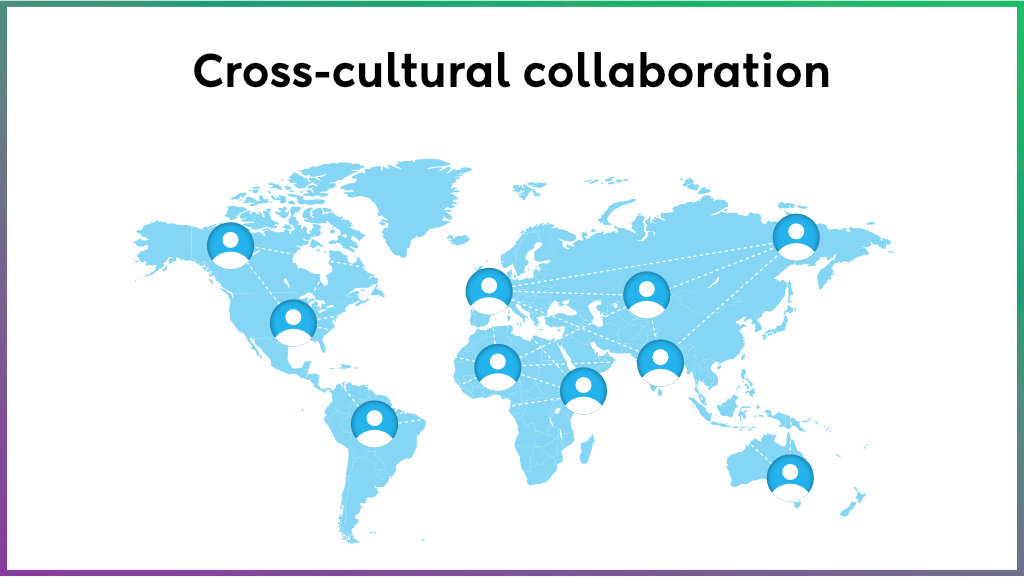
Cross-cultural collaboration refers to the process by which individuals from different national, ethnic, or cultural backgrounds work together to achieve common goals, often within multinational teams or global partnerships. It is central to modern collaboration where distributed workforces and remote work are the norms, and organizational boundaries span countries and continents.
Some cultures rely heavily on non-verbal cues, implicit meanings, and long-standing relationships, whereas others value direct communication, explicit instructions, and clearly defined roles. Misalignment across these dimensions can lead to misinterpretations.
Cross-cultural collaboration is not just about logistics—it also carries relational risks. Miscommunication can fracture trust; divergent attitudes toward hierarchy can derail coordination; and culturally homogeneous subgroups may isolate those from minority cultures. To mitigate these challenges, organizations must establish inclusive team norms, foster cultural self-awareness, and implement onboarding practices that highlight both the shared vision and the localized ways of working.
25. Interprofessional collaboration
Interprofessional collaboration is the process by which professionals from different disciplines, but within the same domain or setting, work together to deliver integrated outcomes. It is commonly practiced in environments such as healthcare, education, public policy, or social services, where responsibilities are distributed among licensed experts with distinct scopes of practice.
Unlike informal teamwork, interprofessional collaboration involves well-defined roles, regulated standards, and often, hierarchical constraints. A physician, nurse, pharmacist, and social worker may all engage with the same patient, but each from a different angle of care. Their collaboration must balance autonomy with coordination, requiring shared goals, transparent communication, and respect for role-specific boundaries.
26. Interdisciplinary collaboration
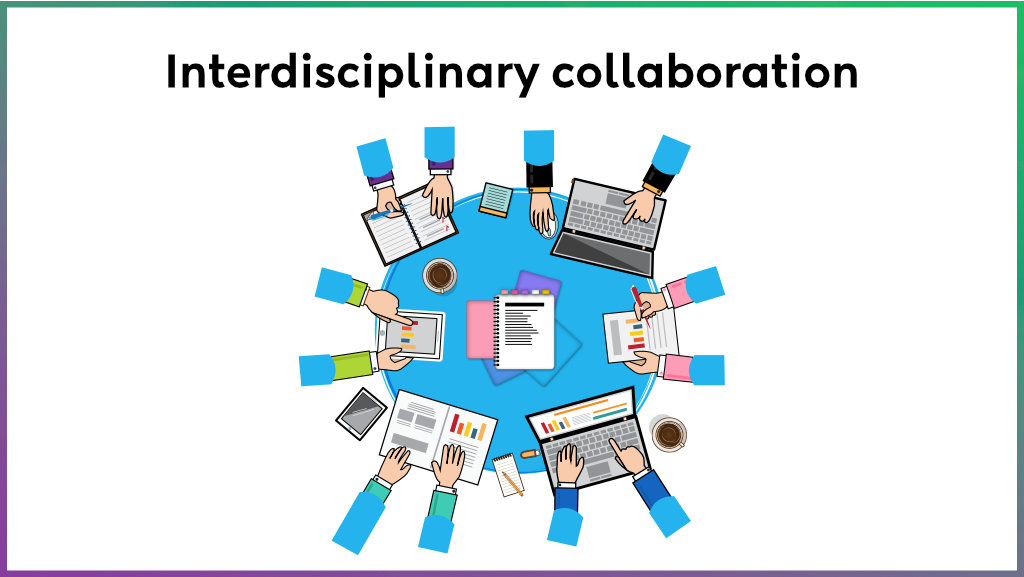
Interdisciplinary collaboration is the integration of knowledge, methods, and perspectives from two or more academic or professional disciplines to solve complex problems, drive innovation, or produce new insights. It is not simply the coexistence of different fields—it is the intentional synthesis of their contributions into a cohesive, novel approach.
This form of collaboration is common in research, innovation labs, sustainability projects, public policy, and advanced product development—contexts where challenges cross the boundaries of traditional expertise. A data scientist working with an urban planner, a behavioral psychologist collaborating with a UX designer, or a climate scientist engaging with an economist—all reflect the kind of boundary-spanning work that defines interdisciplinary teams.
Unlike interprofessional collaboration—which involves distinct roles within the same domain—interdisciplinary work brings together different domains altogether. It requires contributors to go beyond their disciplinary comfort zones, often learning each other’s frameworks, vocabulary, and logic. This makes epistemological flexibility and shared learning central to success.
What factors determine the right type of collaboration for a team?
Selecting the appropriate type of collaboration depends on how the team is structured, what the task demands, and the broader organizational environment. The goal is to align collaboration style with the realities of execution—so teams stay coordinated without unnecessary overhead.
Key factors include:
- Nature of the task: Is the work routine or exploratory? Time-bound or ongoing? Complex, ambiguous projects benefit from interdisciplinary or cross-functional collaboration, while repetitive workflows may require simpler coordination models.
- Diversity of expertise: The more varied the skill sets involved, the more structured the collaboration must be. Interdepartmental or interprofessional collaboration helps ensure each domain’s contribution is integrated meaningfully.
- Team distribution: Co-located teams can rely on synchronous or informal collaboration. Distributed teams—especially across time zones—require asynchronous, virtual, or hybrid models to stay aligned.
- Organizational culture and structure: Flat, flexible companies may thrive on informal, agile collaboration. Hierarchical or process-heavy environments often need formal governance, cross-department steering groups, or well-defined workflows.
- Technology infrastructure: The tools available determine what’s possible. Cloud platforms, communication apps, and project management systems (like ProofHub) enable distributed and real-time collaboration across boundaries.
- Level of interdependence: If teams are heavily reliant on one another to complete tasks, tighter integration is required. Loosely coupled teams may only need periodic alignment.
The ideal collaboration model strikes a balance between autonomy and coordination, tailored to how people work, what they’re trying to achieve, and what systems are in place to support them.
Can an organization use multiple types of collaboration at once?
Yes, most modern organizations operate in layered, dynamic environments where no single collaboration model is sufficient. Different teams, projects, and departments often require different types of collaboration to meet their unique goals.
For example, while a product development team might rely on cross-functional collaboration to build new features, the marketing and sales departments may engage in cross-department collaboration to align go-to-market efforts. Meanwhile, a customer support team may use asynchronous collaboration tools to handle ticket escalations across shifts and time zones.
The key is not in choosing one model but in orchestrating them cohesively—so they complement rather than compete. A unified communication infrastructure, shared project management tools like ProofHub, and clear governance make it possible to layer multiple collaboration styles without fragmentation.
What knowledge is best shared through collaboration?
The most valuable knowledge shared through collaboration is often tacit, contextual, and experience-driven—the kind that doesn’t sit neatly in documents or databases. It includes firsthand insights, workarounds, decision rationales, emerging patterns, and the nuanced understanding that shapes action.
Collaboration helps bring this type of knowledge to the surface by encouraging conversation, co-creation, and reflection. It’s especially effective for:
- Problem-solving insights that evolve during discussion
- Cross-domain reasoning where perspectives need to converge
- Lessons learned that aren’t yet formalized
- Client or user context gathered informally, but essential to relevance
While explicit knowledge (like documented procedures or specs) can be shared asynchronously, collaboration turns static information into shared understanding—which is what ultimately drives better decisions and innovation.
What are the five principles of effective collaboration?
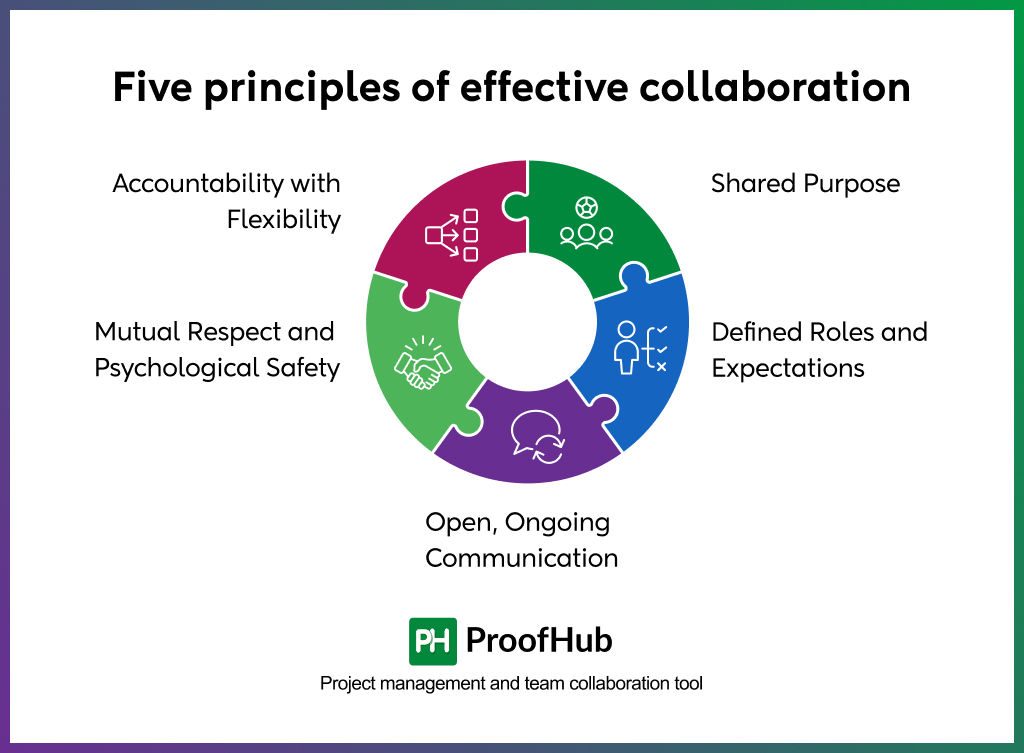
Effective collaboration doesn’t just happen—it’s built on a foundation of clear, shared practices. Here are five principles that consistently support successful collaborative work:
1. Shared Purpose: Everyone involved should understand and align with the core objective. Without a unifying goal, coordination becomes fragmented.
2. Defined Roles and Expectations: Clarity about who’s responsible for what reduces overlap, confusion, and conflict—especially in cross-functional or matrixed teams.
3. Open, Ongoing Communication: Teams must create space for honest dialogue, feedback, and updates. This includes both formal check-ins and informal sharing.
4. Mutual Respect and Psychological Safety: Each team member’s perspective should be valued. When people feel safe to speak up or challenge ideas, better outcomes follow.
5. Accountability with Flexibility: Individuals follow through on commitments but adapt as circumstances change—balancing reliability with responsiveness.
Together, these principles foster alignment, trust, and adaptability—the three core ingredients of real collaboration.
What techniques can be used to encourage collaboration?
Encouraging collaboration requires both cultural reinforcement and practical enablers. Here are several proven techniques that help build a more collaborative environment:
- Create shared goals that cut across teams or functions. When success is collective, so is the effort.
- Use collaboration platforms like ProofHub to centralize work, conversations, and documentation—keeping everyone aligned.
- Establish regular touchpoints, such as check-ins, retrospectives, or joint planning sessions, to maintain visibility and feedback loops.
- Recognize and reward team outcomes, not just individual achievements. This reinforces interdependence.
- Design shared workflows that require joint input—encouraging cross-functional ownership instead of isolated execution.
- Foster informal connection spaces (virtual or in-person), as much of collaboration starts in unstructured dialogue.
- These techniques build momentum by making collaboration a natural part of how work happens, not an added responsibility.
What are the important skills required for effective collaboration?
Effective collaboration depends not just on tools or processes, but on the interpersonal, cognitive, and collaboration skills that make joint work productive. Key skills include:
- Active listening: to fully understand others’ perspectives before responding.
- Clear communication: to articulate ideas, ask questions, and surface blockers without confusion.
- Empathy: to navigate different work styles, needs, and emotional cues.
- Adaptability: to stay flexible when plans shift or priorities change.
- Constructive feedback: to challenge ideas without creating friction.
- Decision-making and prioritization: to move discussions toward outcomes.
Together, these skills create a climate of mutual trust, responsiveness, and clarity—which is essential for collaboration to work consistently, especially under pressure.
What is the end goal of collaboration?
Collaboration, at its core, is not just a method of working—it’s a mechanism for unlocking collective potential. The end goal isn’t merely smoother communication or shared documents. It’s the ability to generate outcomes that no individual, team, or function could achieve alone. When collaboration is done well, it doesn’t just connect efforts—it transforms them.
In practice, this means solving problems more efficiently, making informed decisions, and designing solutions that are more comprehensive, sustainable, and relevant. It means surfacing diverse perspectives early enough to matter, integrating specialized knowledge without friction, and aligning execution with real-world complexity.
But collaboration also has a deeper, often underestimated purpose: to build coherence across the organization. It aligns people not just in what they do, but in how they think, respond, and adapt. It embeds trust into the infrastructure of decision-making. It creates cultures where insight flows freely, where teams self-organize in response to change, and where innovation is a shared outcome—not a departmental goal.
In today’s environment of distributed work, shifting priorities, and accelerating complexity, collaboration is no longer a soft skill or a secondary function. It is a core capability—one that determines whether a company can act with speed, stay resilient under pressure, and grow through uncertainty.
Ultimately, the end goal of collaboration is value creation—not just in the output, but in the process. It enables people to co-create meaning, navigate ambiguity together, and deliver outcomes that carry the signature of collective intelligence. And that is what gives organizations a lasting edge.







